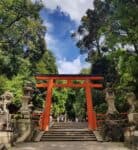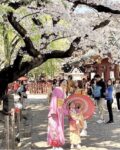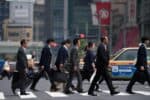Nearly every aspect of Japanese culture changed drastically after the events of World War II. After the devastation of the war, which included many air raids and two atomic bombs, Japanese culture shifted as the society had to be restructured and rebuilt over many years.
How did Japanese culture change after WW2? The end of the war marked the end of Japan’s empire system, marked a shift toward democracy, and brought vast economic restructuring that spread across the country. The post-war American occupation also shaped Japan and introduced many western values that became a part of Japanese culture.


These major changes to Japanese culture helped to reshape the county and its values over the next few decades, and they created the foundation for the Japanese culture that we know today.
Although Japanese culture has changed a great deal since World War II, it is still evident in America today. One of the most obvious ways this can be seen is through food. There are many popular Japanese foods that have been adapted for American tastes, such as sushi and teriyaki chicken.
Taking a closer look at the economic changes, government restructuring, and the effect of western influence can help us understand the immense scope of the cultural changes that shaped Japanese culture after World War II.
Western influence on Japanese culture after WWII
After the war ended, Americans continued to occupy Japan until 1952. During this time, western values, art styles, and entertainment began to influence Japanese culture.
As a result, many Japanese artists created new hybrid styles that blended traditional Japanese influences with western influences.
In turn, American soldiers began to help spread Japanese influences back to the United States and the western world. The previously isolated island country began to embrace aspects of western culture.
Japanese cinema experienced huge changes during and after the postwar occupation. Hundreds of American films were shown all across Japan in order to try to lessen the effects of Japanese propaganda films and to shine a light on American society.
Japanese filmmakers began to produce dynamic films, with action-packed plots. They produced distinctly Japanese stories within a more western framework. Japanese filmmakers began to create visually stunning works of art, including kaiju classics, like Godzilla.

One example of how art styles began to shift is manga. These comics or graphic novels are typically printed in black and white and serialized in magazines. Although the art form has been around since the Edo period, it gained much more widespread popularity in the post-war era.
As Americans began to bring western films and stories to Japan, artists began to create more dynamic and creative manga illustrations and stories.
You can find more about the history of manga and postwar implications in a book by Nobyoshi Hamada called MANGA: The Pre-History of Japanese Comics.
Today, manga is still popular not only in Japan but across the rest of the world as well. Many artists take up an interest in the style and recreate their own comics. Anyone interested in the art form can grab a kit that teaches you to use traditional drawing tools.
One of the goals of the American occupation was to showcase American values and American culture as a model that the Japanese could follow. Some believed that these values would also help boost Japanese citizen’s opinions of Americans and begin to build a peaceful relationship.
During the occupation, western music, film, food, cars, etc. were pumped into Japanese society. In many ways, these snippets of American culture persist today.
Western films still enjoy great success in Japan. In addition, many familiar western clothing and food brands populate the streets of Japan. Even American fast food chains, like Pizza Hut and KFC, are popular in the country.
One of the most successful imports from America has been pizza. The Triple Treat Box at Pizza Hut is a great example of this.
Many street signs even bear English translations. Many western tourists travel to Japan and have no difficulty finding familiar brands and systems throughout the country.
Aside from lasting changes to entertainment and the arts, postwar Japan also saw massive changes to government and economic structures.

Changes to government structure in Post WWII Japan
After the war, the Allied Power began the occupation of Japan which lasted until April 1952. General MacArthur of the United State remained in power during this occupation and was in charge of implementing many changes to the structure of Japan’s government.
Firstly, the Japanese empire was disbanded. This meant that all of the territory that Japan had gained after 1894 suddenly became controlled by the U.S. Japan went from an empire to a single island nation, which made it possible to overhaul their government structure.
The country saw hundreds of war crime trials under this western occupation, many of which ended in execution. Any remains of the Japanese military and war machines were disbanded by MacArthur. In 1947, they instituted a brand new constitution that would shape the future structure of Japan’s government. In this constitution, which was modeled after the United States constitution, put an official end to the Japanese empire, though a ceremonial emperor is still in place today. It also introduced a brand new form of democracy to the Japanese people.
Today, the government of Japan consists of the same three branches as the United States: executive, legislative, and judiciary.
However, Japan remains a constitutional monarchy rather than a pure democracy. This is a system of government in which a monarch shares power with a constitutionally organized government. In Japan’s case, the government combines the three branches along with an emperor who has limited power.
In addition, this new constitution stated that Japan would never build an army or start a war again without consequences.
In order to restructure and stabilize the government, MacArthur also focused on establishing peace between Japan and the United States. By showcasing aspects of American culture to the Japanese people, he hoped to create a long lasting relationship between the two countries.
During this time, the American occupation carefully reviewed Japanese media for any anti-American sentiment and censored anything that did not make the cut. Once the government had been established, the two countries signed an official treaty.

This treaty, known as the Treaty of San Francisco or the Treaty of Peace with Japan established a peaceful relationship between the Allied Powers on behalf of the United Nations. In addition to ending the hostilities, this treaty also required payment to those affected by Japanese war crimes.
This led to the official end of the American occupation of Japan. Although the American forces left Japan in 1952 the occupation had lasting effects on the culture of Japan that persist to this day.
The occupation affected Japanese culture by overhauling their government, but it also affected their economic future. This would turn out to be pivotal.
Changes to the economy in Post WWII Japan

After the events of World War II, the Japanese economy was suffering. In addition to the cost of war, Japan also had to pay back allied forces for war crimes and rebuild after the devastation of air raids, atomic bombs, and other wartime expenses.
Even with a bleak outlook, the Japanese economy managed to bounce back in what is now known as the Japanese Economic Miracle. This unprecedented period of growth lasted from the end of World War II to the end of the Cold War.
The Japanese luxury car brands were a big beneficiary of this growth, and continue to be some of the most popular and prestigious automakers in the world.
This rapid economic growth established Japan as a long lasting global super power.
After MacArthur, also known as SCAP or the Supreme Commander for the Allied Powers, departed and withdrew financial support, Japan’s economy continued to grow. The Japanese government was instrumental in getting the country back on its feet. They helped private sector growth and helped put regulations into place that would assure Japan’s ability to thrive as an independent nation. During the Japanese Economic Miracle, the country not only survived its hardships, but became the second largest economy in the world.
Another aspect that helped boost the postwar economy in Japan was the Korean war. The United States procured equipment and supplies from nearby Japan, rather than shipping them all the way across the sea. Since the Japanese were not directly involved in the conflict, they were able to profit massively from it.
These expenses paid by the United states quickly added up and gave the economy a huge injection of money. This conflict between the United States and Korea also helped stimulate Japan’s industry sector and set them up to expand it. Japan’s industrial growth contributed heavily to the Japanese Economic Miracle.
This age of prosperity for the Japanese proved to be a lasting one. Although the initial gains tapered off, they have maintained their spot as one of the largest economies in the world.
Today, they have a highly developed free market economy. This is an economic system based on supply and demand that has very little government control. This system would not have been possible under the strict control of an empire but has flourished under Japan’s constitutional monarchy.
While many traditional Japanese values permeate their culture, the events of World War II drastically changed the trajectory of the country as a whole. The war, and subsequent postwar occupation led to a dramatic boom in the arts, new long-lasting systems of government, valuable global relationships, and economic prosperity.
Japan today, is pretty much a completely different country at this point in the 21st century. Gone are the days of blind nationalism and now a more “calmer”, less war aspiring nation exists.




























